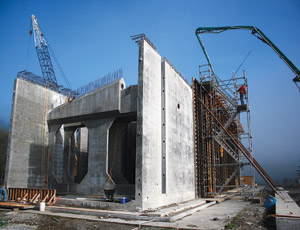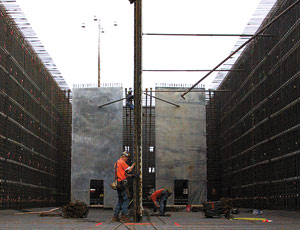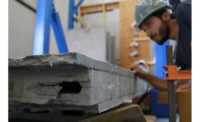The Washington State Dept. of Transportation is creating a list of best construction practices for floating bridges, based on results of tests conducted on a pontoon built at one-sixth the typical size. The best practices will be used by the design-build team that won the contract to build new pontoons for the state Route 520 Evergreen Point Floating Bridge. At 2,285 meters, SR 520's bridge is the longest of its kind in the world.


WSDOT and its contractor, Aberdeen, Wash.-based Quigg Bros. Inc., last month wrapped up the $2.8-million "Advanced Construction Methods and Engineering for Pontoons" project, which comprises 11 stages of pontoon construction, says Scott Ireland, WSDOT project engineer. "We learned a tremendous amount, and our lessons learned exceeded our expectations," Ireland says.
Within the 120-ft-long, 38-ft-wide, 28.5-ft-tall test pontoon section, built south of Olympia, Wash., crews were able to replicate all components of a full-size pontoon. "Significant factors that we focused on included concrete forming methods, the type of concrete used and the methods for placing and curing the concrete while trying to control its temperature," says Ireland.
The overarching goal is to minimize cracks during casting. Even a minuscule crack is considered a structural flaw for a pontoon, because the pontoon will be situated in water. Concrete additives such as fly ash and microsilica generate significant heat during the concrete hydration process, expanding wall sections.
When the concrete cools, the walls tend to shrink and cause vertical cracks at the interface between the botton "keel" slab and the walls. "Acknowledging the concrete generates heat, we then had to develop construction methods to mitigate for it," Ireland says.
Engineers designed a heating system cast in the test keel slab. The temperature of the slab was raised to the point the walls would reach during a typical curing process. Heat sensors ensured accuracy. As the walls began to cool, the heating system was tapered down accordingly. No differential stresses nor shrinkage cracks resulted in the test.
The next step is intense documentation. "We want to learn as many lessons as we can from this project so we can implement changes that will ultimately increase production rates and quality of the real SR 520 pontoons," says Ireland.
The design-build contractor for the SR 520 pontoon construction project, a joint venture of Omaha-based Kiewit Corp. and its Poulsbo, Wash.-based subsidiary General Construction Co., last year bid $367.3 million, leaving $180 million on the table. The plan is to build 33 pontoons in Grays Harbor County.
According to WSDOT, the pontoons will be stored and used in case of a catastrophic failure of the existing SR 520 bridge, which is vulnerable to wind and earthquakes. Barring that, the pontoons will eventually be used as part of a $4.65-billion corridor improvement program, which will include a brand-new six-lane replacement bridge.
Kiewit-General will begin building the casting yard later this year. The plan is to complete four main and six supplemental pontoons every four months, with all 33 finished by 2014.



Post a comment to this article
Report Abusive Comment